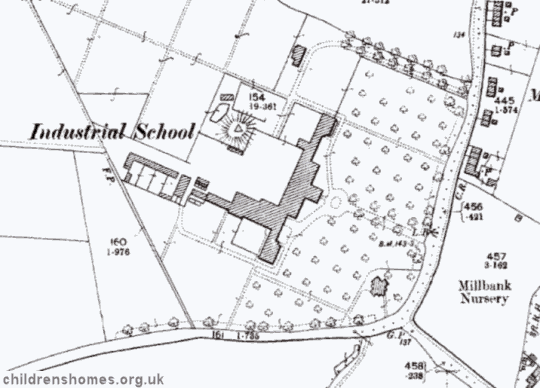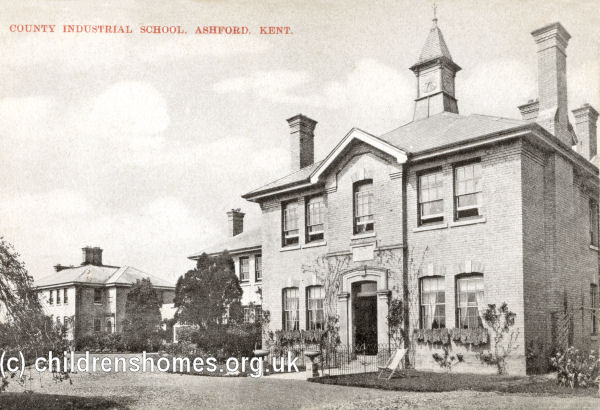Kent County Council Industrial School for Boys (Stanhope School), Ashford, Kent
In 1875, Kent County Council opened its Industrial School for Boys in purpose-built premises at Kingsnorth Road, Kingsnorth, near Ashford. On October 26th, 1875, the establishment first accommodation block was certified to accommodate 40 boys. A second block was completed the following year, taking the total accommodation to 90 places. Mr and Mrs James Duke were appointed as the School's first superintendent and matron.
In 1879, it was reported that the School now had nearly 80 acres of farmland, which provided abundant occupation for the boys. There was also a carpenter's shop, bakehouse, and a good garden. The boys made and washed their own clothing. A good band had been established.
Further building work was completed in 1881 and included two further accommodation blocks, a schoolroom, superintendent's house, office, and board room. The four accommodation blocks, each under the charge of its own matron, were connected by a covered corridor. A total of 200 places was now available at the School. The layout of the site is shown on the 1898 map below.

Kent County Council Industrial School for Boys site, Ashford, c.1898.

Kent County Council Industrial School for Boys from the south-east, Ashford, early 1900s. © Peter Higginbotham
A report in October, 1896, described the School as an institutional building, consisting of a main block with two wings, and at the rear various out-buildings. The institutional aspect of the interior was said to be 'aggressive', with whitewash reigning supreme. A wash warmer in tint was suggested. The sickroom was described as being not over cheerful, in contrast to the School's new play-shed, which was delightful. Of the School's 80 acres of land, about 25 were in vegetables and fruit, the rest in grass. The stock consisted of 2 horses, 24 cows (12 in milk) and calves, and about 20 pigs. The allocation of the boys to the various occupations on that date was: garden, 34; farm and stock, 12; stone-yard, 23; band, 26; house-boys, 11; dormitories and boots, 16; kitchen, 6; bakehouse, 1; laundry, 6; tailors, 7; carpenters, 5; duty boys, 4. The remainder of the boys on that occasion were at drill. The brass and reed band consisted of 40 boys, and regularly provided entrants to army bands. There was a good asphalted playground with a large covered shed, in which some gymnastic apparatus was installed although no instruction was being provided. Physical and military drills were given, however. There was by now large outdoor swimming bath for summer use, measuring 100 feet by 95 feet. There was a field available in decent weather for cricket and football, and outside matches were arranged. A neighbouring friend invited boys to fishing parties, and in the summer excursions were arranged from time to time, including one to the sea. There was a good library, and the 'Graphic' was taken. In the winter, entertainments were organised, in which the band played a prominent part. A mark system was in operation carrying monetary rewards of from 1d. to 8d. a month. Some of the money was available when the boys had a day's outing, the rest being banked until they left the School.

Kent County Council Industrial School for Boys band, Ashford, 1906. © Peter Higginbotham
On June 15th, 1898, Mr and Mrs T.S. Babington took over from the Dukes as superintendent and matron. They were still in post in 1911, at which date other staff included: assistant matron, Miss D. Babington; schoolmaster, Mr W.L. Barnett; assistant schoolmasters, Mr G.C. Tingley and Mr P.T. Kelly; a labour master, band master, manual instructor, tailor, cook and baker, carpenter, cowman, two gardeners, carter, labourer. Needlewoman, dairy woman and domestic servant. Mr. H.T. Peplow was the visiting dentist. It was perhaps under the latter's influence that toothbrushes for all boys had now been introduced.

Kent County Council Industrial School for Boys from the east, Ashford, early 1900s. © Peter Higginbotham
In the 1920s, the establishment adopted the name Stanhope School.
In 1933, Stanhope became an Approved School, one of the new institutions introduced by the 1933 Children and Young Persons Act to replace the existing system of Reformatories and Industrial Schools. The School could then accommodate up to 126 Intermediate Boys, aged between their 13th and 15th birthdays at their date of admission. Training was provided in farming, gardening and woodwork. The headmaster in 1935 was Mr W.D. Blackshaw.
In about 1941, the School was evacuated to Ty Mawr at Gilwern, near Abergavenny. The administration of the establishment was then handed over to Breconshire County Council.
The Kingsnorth site was later home to Stanhope Primary School but the buildings no longer survive.
Records
Note: many repositories impose a closure period of up to 100 years for records identifying individuals. Before travelling a long distance, always check that the records you want to consult will be available.
- Kent History and Library Centre, James Whatman Way, Maidstone, Kent ME14 1LQ Holdings include: Boys' admission registers (1876-95); Girls' admission register (1874-91); Register of boys admitted to Stanhope School (1895-1930); Copy of licences to reside outside the school (1910-19); Register of correspondence with boys' relatives (1919-22); Medical officers' report book (1895-1907); Notes recording the subsequent careers of boys licensed (1895-1930); Visitors' and inspectors' reports (1894-1940); Stanhope School journal (1919-42).
Census
Bibliography
- Higginbotham, Peter Children's Homes: A History of Institutional Care for Britain's Young (2017, Pen & Sword)
- Mahood, Linda Policing Gender, Class and Family: Britain, 1850-1940 (1995, Univeristy of Alberta Press)
- Prahms, Wendy Newcastle Ragged and Industrial School (2006, The History Press)
- Higginbotham, Peter Children's Homes: A History of Institutional Care for Britain's Young (2017, Pen & Sword)
- Hyland,Jim Yesterday's Answers: Yesterday's Answers: Development and Decline of Schools for Young Offenders (1993, Whiting and Birch)
- Millham, S, Bullock, R, and Cherrett, P After Grace — Teeth: a comparative study of the residential experience of boys in Approved Schools (1975, Chaucer Publishing)
Links
- None noted at present.
Except where indicated, this page () © Peter Higginbotham. Contents may not be reproduced without permission.


